A stationary bike builds leg muscle through a combination of resistance and cardiovascular training. As you pedal, you're engaging major muscle groups like quadriceps, hamstrings, calves, and glutes. The resistance on the bike acts as strength training, causing micro-tears in muscle fibers that lead to growth when repaired. Proper form, including correct seat height and core engagement, is essential for effective leg development. Interval training can further boost muscle strength and calorie burn. Additionally, the cardiovascular benefits of cycling improve blood flow and nutrient delivery to muscles, enhancing overall growth and recovery. To maximize results, consider your post-workout nutrition and rest periods. There's more to learn about optimizing your stationary bike workouts for leg muscle development.
Core Insight
- Stationary bikes engage major leg muscles including quadriceps, hamstrings, calves, and glutes during pedaling.
- Increased resistance on the bike acts as strength training, causing muscle fiber tears and subsequent growth.
- Interval training on stationary bikes improves muscle strength while burning calories and enhancing cardiovascular fitness.
- Proper form, technique, and bike setup are crucial for effective leg muscle development during cycling.
- Consistent training over time leads to gradual muscle adaptation, strength development, and long-term benefits.
Muscles Engaged During Cycling
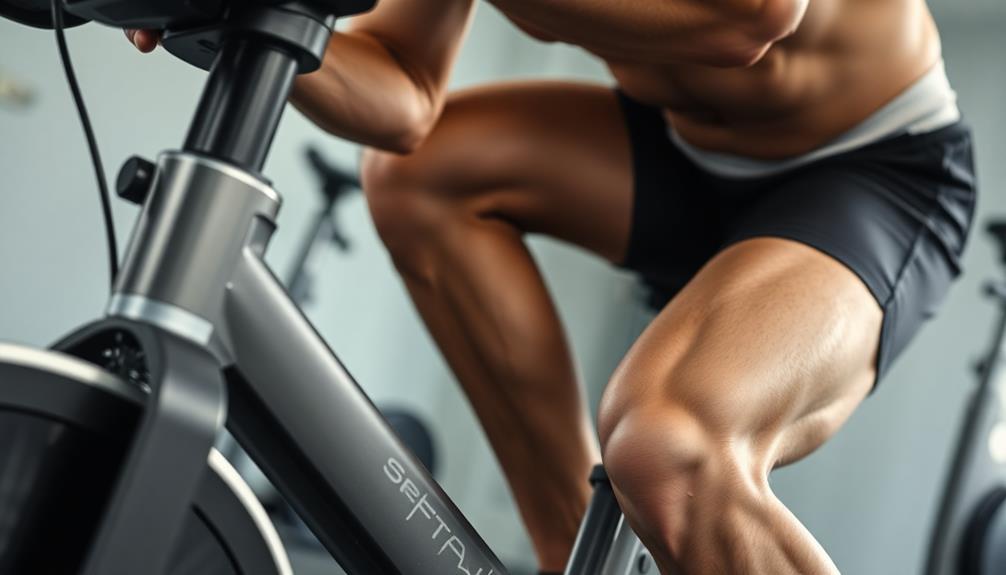
When you ride a stationary bike, three main muscle groups do the work: the quadriceps, hamstrings, and calves. The quadriceps are the muscles on the front of your thighs. They straighten your knee and push the pedal down. You'll feel these muscles working the hardest. Wearing compression sleeves on your calves or knees can give you extra support and maybe even help you pedal better.
The hamstrings are on the back of your thighs. They bend your knee and pull the pedal up. These muscles help make your pedaling smooth and even. Your calf muscles, especially the gastrocnemius and soleus, point your toes and keep your ankle steady as you pedal.
Your glutes and hip flexors also pitch in, but not as much. They assist your legs and add power to your pedaling.
Resistance and Muscle Growth

Resistance is the secret to building muscle on an exercise bike. As you pedal against more resistance, you're basically strength training your legs. This resistance makes your muscles work harder, causing small tears in the muscle fibers. When your body repairs these tears, it builds stronger, bigger muscles. Just like nutritious food helps muscles grow, the resistance on an exercise bike gives your leg muscles the push they need to develop.
To get the most muscle growth, gradually increase the resistance over time. This challenges your muscles and keeps them growing and getting stronger. It's important to find the right balance between resistance and good form. Start with a level that's tough but still lets you maintain proper technique during your workout. As you get stronger, slowly increase the resistance to keep pushing your muscles to adapt and grow.
Cardiovascular Benefits for Muscle Building

Stationary cycling doesn't just build muscle; it also improves your cardiovascular system. Better cardiovascular fitness helps muscle growth in several ways:
- More blood flow to muscles
- Nutrients delivered more efficiently
- Muscles use oxygen better
- Faster recovery between workouts
When your heart pumps blood more effectively, your muscles get more oxygen and nutrients. Improved circulation also removes waste from muscles, so you feel less tired and sore. You'll build more endurance too, so you can exercise longer and harder. This lets you push yourself more during strength training, leading to bigger muscle gains over time. Stationary cycling and resistance training work together for well-rounded leg development. Adding supplements that help your body handle stress and recover can also boost your overall fitness results.
Proper Form for Leg Development

To build strong legs on a stationary bike, you need good form. First, set the seat so your knee has a slight bend at the bottom of the pedal stroke. Sit up straight and engage your core. Put the balls of your feet on the pedals. Push down through your heels and pull up with the back of your legs as you pedal. Keep your knees straight, not pointing in or out. Pedal smoothly, not bouncing in the seat. For a harder workout, increase the bike's resistance or stand up while pedaling. Keep your upper body relaxed and don't grip the handlebars too tight. After tough rides, try using cold therapy wraps on your legs. They reduce swelling and help your muscles recover faster.
Interval Training on Stationary Bikes
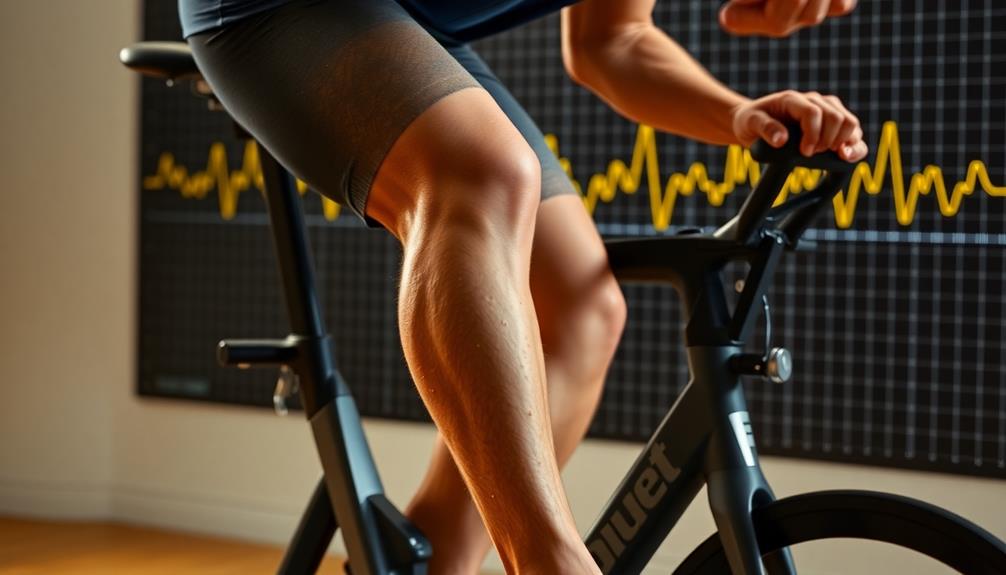
Interval training on stationary bikes is a great way to build leg muscles and improve heart health. It works by switching between fast bursts and slower recovery periods. This helps you burn more calories and get stronger. After your workout, think about having a snack with lots of carbs to refuel and help your muscles recover.
Here's how to get started:
- Pedal at a medium speed for 5-10 minutes to warm up
- Go as fast as you can for 30 seconds
- Slow down for 1-2 minutes to catch your breath
- Do this 8-10 times in a row
Over time, try to pedal faster and for longer during the fast parts. You can also shorten the recovery time to make it harder. Cool down for 5-10 minutes when you're done. Aim to do interval training 2-3 times a week for the best results in building leg muscles and getting fitter overall.
Progressive Overload Principles

Building muscle effectively relies on the idea of progressive overload. This means slowly making your muscles work harder over time. While supplements like vegan pre-workouts can help, what matters most is putting in consistent effort. When using a stationary bike, you can apply progressive overload in a few ways:
- Resistance: Slowly turn up the bike's resistance level.
- Duration: Make your workouts a bit longer each time.
- Frequency: Add more bike sessions to your week.
- Intensity: Pedal faster or with more power.
Nutrition for Muscle Gain
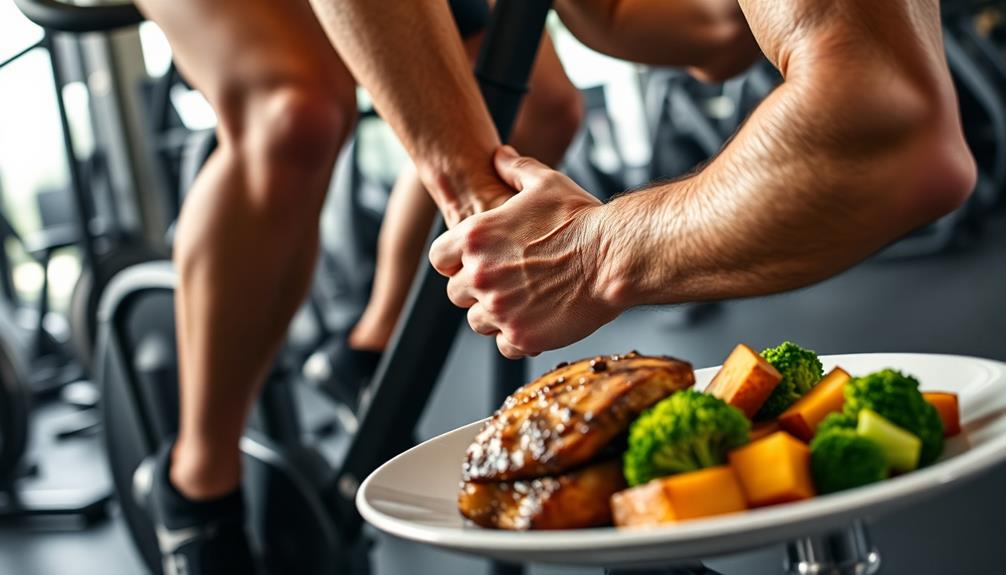
Your diet is crucial for building muscle while using a stationary bike. Eat a balanced diet with protein, complex carbs, and healthy fats to support muscle growth. Mushroom extracts can also help endurance athletes recover better and boost their immune system. Try to eat a meal with these nutrients within an hour after your workout to help your muscles recover and grow.
Important nutrients for building muscle are:
- Protein (lean meats, fish, eggs, dairy)
- Complex carbs (whole grains, veggies)
- Healthy fats (nuts, avocados, olive oil)
- Vitamins and minerals (fruits, leafy greens)
Don't forget to drink lots of water all day long. It keeps your muscles working well and helps your overall performance. Supplements can help, but they shouldn't replace whole foods. Use them to add to your diet when needed. Stick to your nutrition plan and work out regularly on your stationary bike to reach your muscle-building goals.
Recovery and Rest Importance
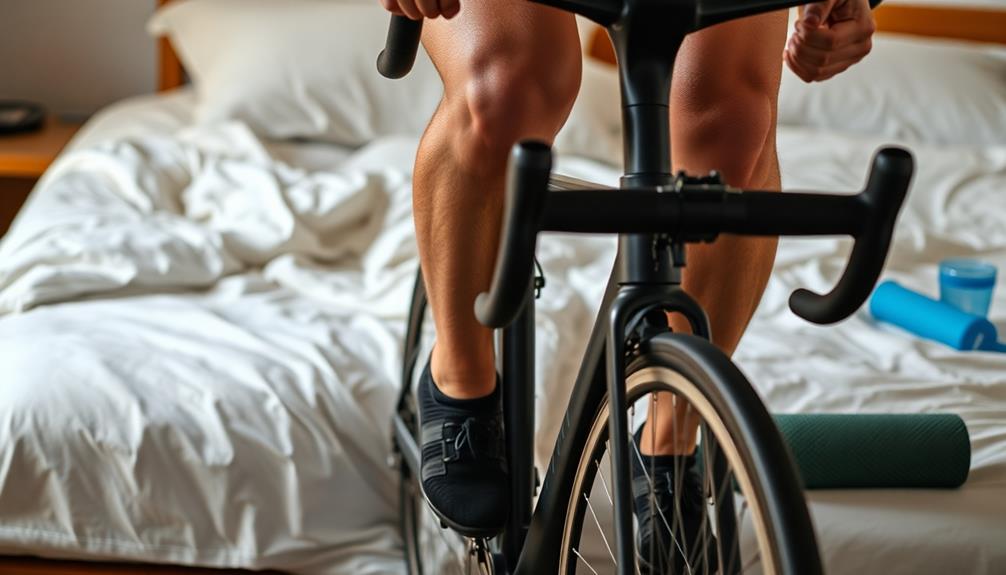
Rest and recovery are crucial for building muscle when using a stationary bike. Your body needs time to repair stressed muscle fibers after workouts. Take at least one full rest day between intense cycling sessions. Soaking in Epsom salt baths can soothe sore muscles and speed up recovery.
During rest periods, focus on getting enough sleep. This is when your body produces growth hormones that help repair muscles. Aim for 7-9 hours of quality sleep each night. You can also include active recovery days in your routine, like light cycling, stretching, or low-impact activities that improve blood flow without overworking your muscles.
Don't forget to stay hydrated and eat well during recovery. Consume enough protein and complex carbohydrates to support muscle repair and refill energy stores.
Complementary Exercises for Cyclists
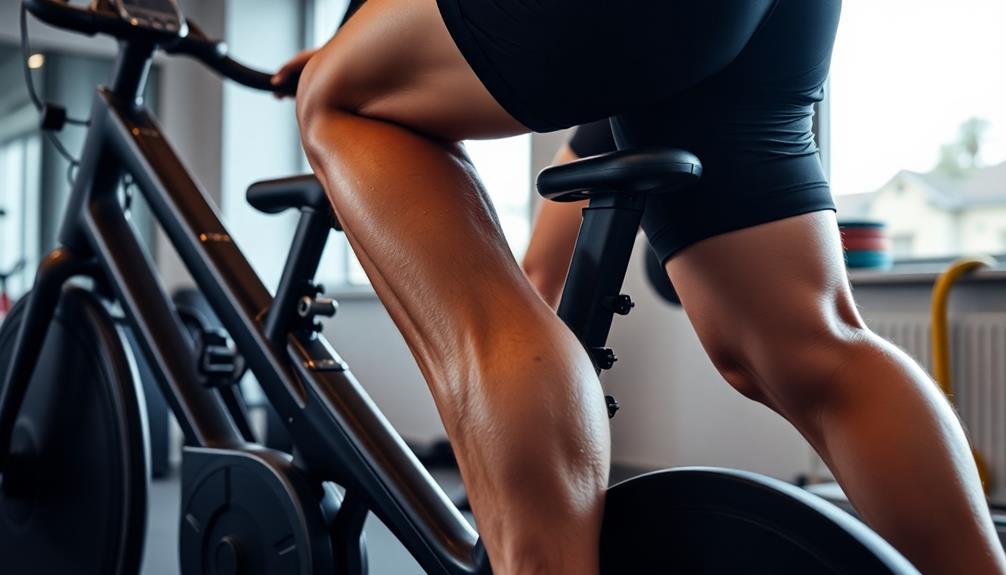
Cyclists who want stronger legs shouldn't just ride their bikes. Adding other exercises to your workouts can help build leg strength and muscle. Using compression sleeves during exercise can support your muscles, reduce fatigue, and boost recovery. Try these four exercises along with cycling:
- Squats
- Lunges
- Deadlifts
- Calf raises
Squats and lunges work your quads, hamstrings, and glutes. Deadlifts target your back muscles. Calf raises focus on your lower legs, which help with pedaling. These moves improve overall leg strength, balance, and stability for better cycling and less injury risk. Start with good form and slowly add weight and reps as you get stronger.
Long-Term Muscle Adaptations
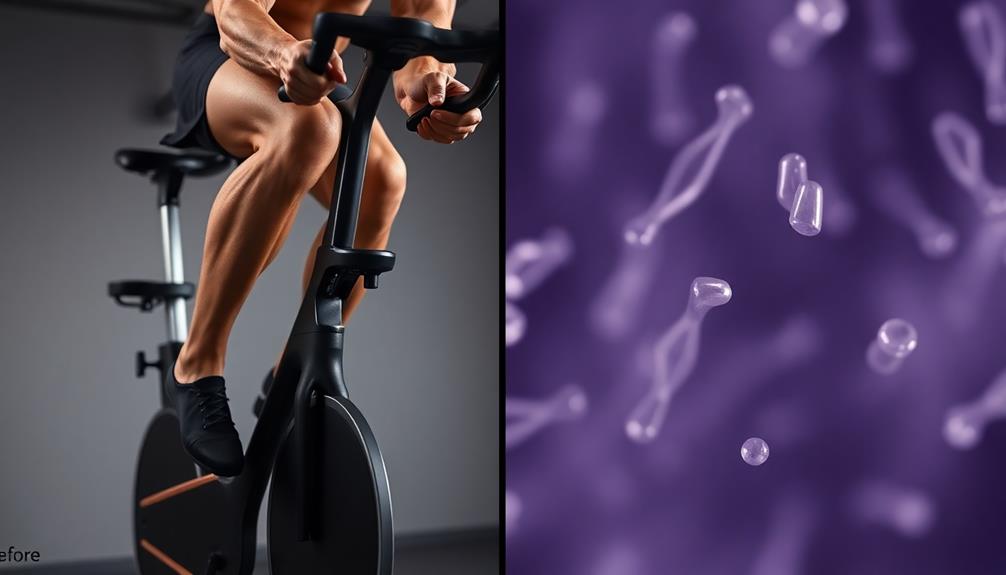
Consistency is key when it comes to long-term muscle changes from stationary bike training. As you regularly do cycling workouts, your leg muscles will go through various changes. Over time, you'll notice better muscle endurance, allowing you to pedal for longer without getting tired. Your slow-twitch muscle fibers will get better at using oxygen, improving your overall cardiovascular fitness. To help your muscles recover and grow, think about adding high-carb powders to your post-workout nutrition. These supplements can help refill glycogen stores and promote muscle repair.
You'll also see hypertrophy, or muscle growth, especially in your quadriceps, hamstrings, and calves. This growth comes from the repeated stress put on these muscles during cycling. Plus, your body will get better at activating motor units, increasing your power output and efficiency on the bike. These changes don't happen overnight, so it's important to stick to a consistent training schedule. Keep in mind, progress may be gradual, but the long-term benefits for your leg muscles are significant.
Frequently Asked Questions
Can Stationary Bike Cycling Cause Knee Pain or Injury?
Yes, stationary bike cycling can cause knee pain or injury if you're not using proper form or if you overexert yourself. It's important that you adjust the bike correctly, maintain good posture, and don't push beyond your limits.
How Long Should a Beginner's Stationary Bike Workout Last?
As a beginner, you'll want to start with 10-15 minute sessions on your stationary bike. You can gradually increase your workout time to 20-30 minutes as you build endurance. Don't push yourself too hard initially.
Is a Recumbent Bike as Effective for Leg Muscle Building?
You'll find recumbent bikes can be effective for leg muscle building. They target your quads, hamstrings, and calves, but may engage your glutes less than upright bikes. Your workout intensity and duration will ultimately determine muscle-building effectiveness.
Can Stationary Bike Cycling Help With Weight Loss and Muscle Toning Simultaneously?
Yes, you can achieve weight loss and muscle toning simultaneously with stationary bike cycling. It's an effective cardio workout that burns calories while also engaging your leg muscles, helping you shed fat and build strength concurrently.
Are There Age Limitations for Building Leg Muscle Through Stationary Bike Workouts?
You're never too old to build leg muscle with stationary bike workouts. While younger people may see faster results, you can still make gains at any age. It's important to start gradually and listen to your body.

